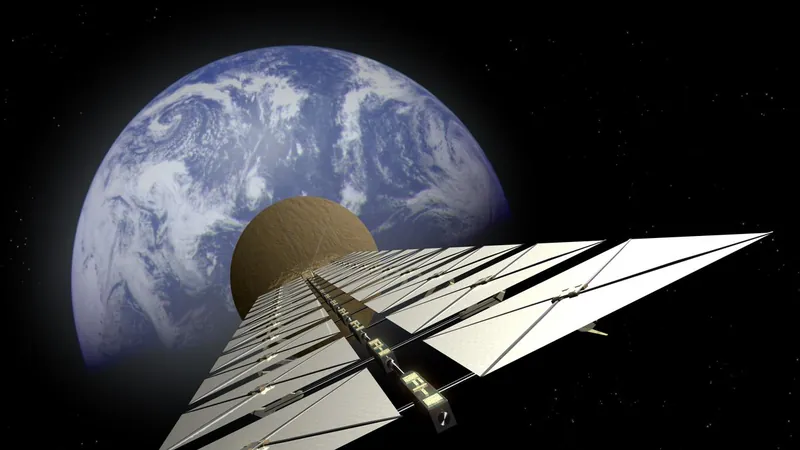
The Future of Space Technology: 4 Innovations That Could Transform Our Access to the Cosmos
2024-10-08
Author: Ying
1. Space Solar Farms: A Game Changer for Energy Supply (2040s-2050s)
Imagine a future where solar farms orbit the Earth, capturing the sun’s energy without the interference of clouds or the atmosphere. Currently, solar power contributes just over 5% of the world’s electricity, but innovative solutions could allow us to harness much more from space where solar panels receive uninterrupted sunlight.
The recent successful demonstration by Caltech’s Space Solar Power Demonstrator proves there is momentum in this field. In 2023, a device successfully converted solar energy into microwave power and beamed it back to a receiving station. On the horizon, Japan’s JAXA aims to develop a solar power system that could deliver one gigawatt of energy to Earth, comparable to a nuclear power plant.
However, constructing such a massive solar array poses daunting engineering challenges. Significant advancements in technology, materials, and mechanisms would be necessary. Furthermore, keeping a microwave beam accurately directed towards a receiving area—while avoiding unintended damage—will require careful design and testing.
2. Space Elevators: Is the Sky Not the Limit? (Second Half of the 21st Century)
The concept of a space elevator has long lived in the realm of science fiction, but it’s gradually inching toward feasibility. By deploying a cable extending from near the equator into space, this technology could allow for transportation to orbit without the need for traditional rocket propulsion.
While experts believe that the ultimate material—strong enough to withstand the immense forces involved—would be carbon nanotubes, current limitations in their production present a challenge. Meanwhile, some researchers propose constructing a lunar space elevator that could significantly reduce fuel costs for missions between Earth and the Moon, showcasing how innovative thinking can pave new ways for space infrastructure.
3. Nuclear Power on the Moon: Energizing Lunar Bases (2030s)
With plans underway for establishing a sustained human presence on the Moon, reliable energy sources are crucial. Solar energy may be insufficient due to the lunar day-night cycle. Therefore, nations are racing to develop nuclear fission reactors that could operate on the Moon’s surface.
NASA has already chosen designs for reactors that could provide power for at least a decade, while Russia and China collaborate on their own initiatives. The challenges, such as managing reactor waste heat in the Moon’s airless environment, are substantial but not insurmountable. Successfully overcoming these hurdles could mark a significant advancement in human exploration and settlement on our lunar neighbor.
4. Interstellar Travel: Beyond the Stars (2070s-2120s)
The quest for interstellar travel ignites the imagination, yet the vast distances to even the closest stars present a monumental challenge. Current spacecraft, like NASA’s New Horizons, can take tens of thousands of years to reach our nearest stellar neighbors. Innovative proposals, such as Project Daedalus and the Breakthrough Foundation’s Project Starshot, aim to develop vessels capable of traveling at a significant fraction of the speed of light.
While promising, these projects face immense technological hurdles, including the need for powerful laser systems to propel spacecraft. One potential solution might involve the solar farms envisioned for Earth orbit, harnessing their energy to power interstellar missions, thus interlinking our solar energy solutions with our quest to reach distant stars.
As we stand on the brink of these technological advancements, the challenges are vast—but they are accompanied by opportunities that could redefine our capabilities in space exploration. Keep an eye on these innovations, as they may soon change the way we live, work, and explore beyond our planet. The future is shining brightly just beyond the stars!



 Brasil (PT)
Brasil (PT)
 Canada (EN)
Canada (EN)
 Chile (ES)
Chile (ES)
 España (ES)
España (ES)
 France (FR)
France (FR)
 Hong Kong (EN)
Hong Kong (EN)
 Italia (IT)
Italia (IT)
 日本 (JA)
日本 (JA)
 Magyarország (HU)
Magyarország (HU)
 Norge (NO)
Norge (NO)
 Polska (PL)
Polska (PL)
 Schweiz (DE)
Schweiz (DE)
 Singapore (EN)
Singapore (EN)
 Sverige (SV)
Sverige (SV)
 Suomi (FI)
Suomi (FI)
 Türkiye (TR)
Türkiye (TR)